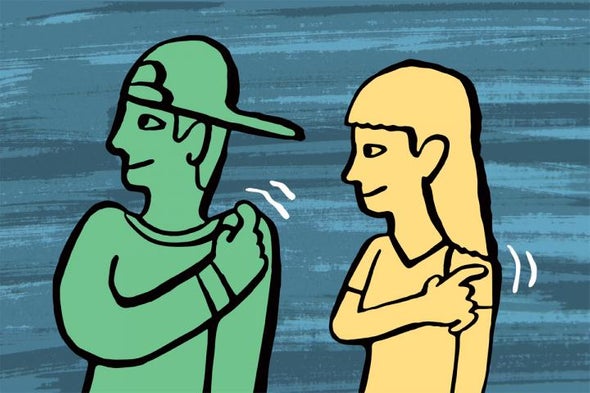(单词翻译:单击)
听力文本
This is Scientific American — 60-Second Science. I'm Karen Hopkin.
Everyone knows what it's like to itch. And the sensation can drive you mad. Or, if you're Yan-Gang Sun of the Chinese Academy of Sciences, it can drive you to explore how the brain tells you it's time to scratch: "Our study is aiming to understand the brain mechanism that promotes the itch-scratching cycle."
Itching can be caused by a number of irritants, from allergic reactions and abrasive textures to bug bites, skin conditions, infections or drugs. The usual solution is to simply scratch. But this cycle of itching and scratching, if it continues unabated, can actually damage tissue — like if you scratch yourself raw.
And Sun notes that: "Effective treatment for chronic itch is still lacking. This is largely due to our limited knowledge about the neuromechanism of itch."
Over the past 10 years, scientists have learned a lot about how the itch signal is carried from the skin to the spinal cord.
"In contrast, we know very little about how the itch information is processed in the brain, and how the brain can dynamically modulate the processing of itch."

Sun and his colleagues focused their attention on the periaqueductal gray...a brain region known to be involved in handling the closely related sensation of pain. They started by exposing mice to histamine or the antimalarial drug chloroquine, both of which trigger scratching.
And they found that this itch-inducing treatment activates a particular set of neurons within the periaqueductal gray: neurons that produce a neurochemical called Tac1.
When the researchers then eliminated this set of neurons, scratching was significantly diminished. And when they activated the neurons — even in the absence of a chemical irritant — the scratching resumed. Sun thus thinks of these Tac1-expressing neurons as the itch neurons in the brain. Getting these neurons firing makes animals itchy and gets them to scratch. His findings appear in the journal Neuron.
"These itch neurons in the brain can be a potential central therapeutic target for breaking the vicious itch-scratching cycle associated with chronic itch."
Which could be a big relief for many irritated people.
For Scientific American — 60-Second Science. I'm Karen Hopkin.
参考译文
这里是科学美国人——60秒科学。我是凯伦·霍普金。
每个人都知道瘙痒是什么感觉。这种感觉会让人发疯。或者,如果你是中国科学院的孙衍刚,那瘙痒会驱使你去探索大脑是如何告诉你该抓痒的:“我们的研究旨在了解启动‘瘙痒-抓挠’循环的大脑机制。”
瘙痒可能由多种刺激物引发,比如过敏反应、粗糙材质、虫子叮咬、皮肤疾病、传染疾病或药物等。通常的解决方法就是简单地挠一挠。但如果“瘙痒-抓挠”循环持续不减的话,可能会对人体组织造成损害,比如抓破自己的皮肤。
孙衍刚指出:“现在仍然缺乏有效治疗慢性瘙痒的方法。这主要是因为我们对瘙痒神经机制的了解有限。”
在过去的10年里,科学家已经掌握了瘙痒信号从皮肤传递到脊髓的方式。
“相比之下,我们对大脑如何处理瘙痒信息、如何动态调节瘙痒过程却知之甚少。”
孙衍刚和同事重点关注中脑导水管周围灰质区,目前已知这一大脑区域参与处理与瘙痒密切相关的痛感。他们首先让老鼠接触组胺或抗疟药氯喹,二者都能触发抓挠行为。
他们发现,这种诱发抓痒的药物会激活中脑导水管周围灰质区内的一组特定神经元,这些神经元会产生一种叫“Tac1”的神经化学物质。
研究人员消除了这组神经元后,抓挠行为明显减少。而当研究人员激活这些神经元时,即使缺少化学刺激,抓痒行为也会再次出现。因此,孙衍刚认为,这些表达Tac1的神经元是大脑中的瘙痒神经元。刺激这些神经元会让动物感觉瘙痒,然后开始抓挠。他的研究发表在《神经元》期刊上。
“大脑中的这些瘙痒神经元可能成为潜在的中心治疗靶点,能打破与慢性瘙痒相关的‘瘙痒-抓挠’恶性循环。”
对许多被瘙痒惹恼的人来说,这可能是巨大的安慰。
谢谢大家收听科学美国人——60秒科学。我是凯伦·霍普金。
译文为可可英语翻译,未经授权请勿转载!
重点讲解
重点讲解:
1. aim to do sth. 致力于;旨在;以…为目标;
They are aiming to reduce unemployment by 50%.
他们正力求使失业人数下降50%。
2. be due to 由于;因为;
I was relieved to find out that my problems were due to a genuine disorder.
得知我的问题确实是由于病症引起的,我松了口气。
3. in contrast 相比之下;与…相反;
In contrast, the lives of girls in well-to-do families were often very sheltered.
相反,生活在富裕家庭的女孩子通常都备受呵护。
4. be involved in 卷入的;参与的;与…有密切关联的;
They have been involved in a campaign of deceit.
他们参与了一系列的欺骗活动。


